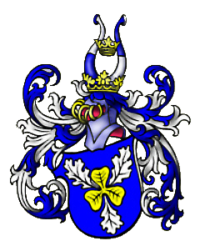House of Bismarck
| House of Bismarck | |
|---|---|
 von Bismarck coat of arms | |
| Country | Germany |
| Founded | c. 1270 |
| Founder | Herebord von Bismarck |
| Current head | Ferdinand, Prince of Bismarck |
| Titles |
|
The House of Bismarck is a German noble family that rose to prominence in the 19th-century, largely through the achievements of the statesman Otto von Bismarck. He was granted the hereditary title of Prince of Bismarck in 1871, a hereditary comital title in 1865 and a ducal title, Duke of Lauenburg, held only for his own lifetime. Several of Otto's descendants, notably his son Herbert, Prince of Bismarck, were also politicians.[1]

The family has its roots in the Altmark region, descending from one Herebord von Bismarck (d. 1280), the first verifiable holder of the name, mentioned about 1270 as an official (Schultheiß) at the city of Stendal in the Margraviate of Brandenburg. His descent from the nearby small town of Bismark is conceivable though not ascertained. His relative Nikolaus von Bismarck (d. 1377) was a councillor and a loyal supporter of the Wittelsbach margrave Louis I, over which he fell out with the revolting Stendal citizens and was compensated with the manor of Burgstall in 1345. By a 1562 agreement with the Hohenzollern margraves, the Bismarcks swapped Burgstall with Schönhausen, located east of the Elbe river and formerly part of the Archbishopric of Magdeburg, which also had been under Hohenzollern rule since 1513.
A Prussian Junker family, their most notable member Otto von Bismarck gained the comital title (Graf) of Bismarck-Schönhausen in 1865 and the hereditary princely status of a Fürst von Bismarck after the Franco-Prussian War in 1871. Two ships of the German Imperial Navy (Kaiserliche Marine), as well as a battleship from the World War II-era, were named after Otto von Bismarck. Also named in his honour were the Bismarck Sea and Bismarck Archipelago (both near the former German colony of New Guinea), as well as several places in the United States, among them Bismarck, North Dakota, the state's capital.
Schönhausen line


- Jkr. Karl Alexander von Bismarck (1727–1797) – married in 1762 Christiane Charlotte Gottliebe von Schönfeldt at Werben
- Jkr. Ernst Friedrich Alexander von Bismarck (1763–1820)
- Jkr. Theodor von Bismarck (1790–1873), married in 1817 Karoline Countess von Bohlen, progenitor of the Bismarck-Bohlen branch
- [...]
- Jkr. Theodor von Bismarck (1790–1873), married in 1817 Karoline Countess von Bohlen, progenitor of the Bismarck-Bohlen branch
- Jkr. Friedrich Adolf Ludwig von Bismarck (1766–1830), Prussian General Lieutenant
- Jkr. Karl Wilhelm Ferdinand von Bismarck (1771–1845), landowner at Schönhausen, married in 1806 Luise Wilhelmine Mencken
- Jkr. Bernhard von Bismarck (1810–1893), Prussian chamberlain (Kammerherr), member of the Prussian Landtag, married in 1841 Adelheid Fanninger (died 1844), secondly in 1848 Malwine von Lettow-Vorbeck
- Jkr. Philipp von Bismarck (1844–1894)
- Jkr. Gottfried von Bismarck (1881–1928)
- Jkr. Klaus von Bismarck (1912–1997)
- Jkr. Philipp von Bismarck (1913–2006), former member of the Bundestag
- Jkr. Herbert Rudolf von Bismarck (1884–1955)
- Jkr. Gottfried von Bismarck (1881–1928)
- Jkr. Philipp von Bismarck (1844–1894)
- HSH Otto, Prince von Bismarck, Duke of Lauenburg (1815–1898), First Chancellor of Germany, Fürst von Bismarck from 1871
- Countess Marie von Bismarck-Schönhausen (1847–1926)
- HSH Herbert, Prince von Bismarck (1849–1904)
- Countess Hannah Leopoldine Alice von Bismarck-Schönhausen (1893–1971)
- Countess Maria Goedela von Bismarck-Schönhausen (1896–1981) ∞ Count Hermann Keyserling (1880–1946)
- Count Manfred Keyserling (1920–2008)
- Count Arnold Keyserling (1922–2005), renowned philosopher
- HSH Otto Christian Archibald, Prince von Bismarck (1897–1975), former member of the Bundestag
- HSH Ferdinand, Prince von Bismarck (born 1930)
- Count Carl-Eduard von Bismarck-Schönhausen (born 1961), former member of the Bundestag
- Count Gottfried von Bismarck-Schönhausen (1962–2007)
- Count Gregor von Bismarck-Schönhausen (born 1964)
- Countess Marina von Bismarck-Schönhausen (born 1986)
- Countess Vanessa von Bismarck-Schönhausen (born 1971)
- Laszlo Weiner (born 2008)
- Cosmo Weiner (born 2012)
- Count Alexander von Bismarck-Schönhausen (1935–1992)
- Countess Claudia Anna Katharine Mona von Bismarck-Schönhausen (* 1964)
- Count Maximilian von Bismarck-Schönhausen (born 1947)
- Count Konstantin von Bismarck-Schönhausen (born 1987)
- Count Alexander von Bismarck-Schönhausen (born 1989)
- Countess Gunilla von Bismarck-Schönhausen (born 1949)
- Count Leopold von Bismarck-Schönhausen (born 1951)
- HSH Ferdinand, Prince von Bismarck (born 1930)
- Count Gottfried von Bismarck-Schönhausen (1901–1949), member of the Reichstag
- Countess Vendeline von Bismarck-Schönhausen
- Countess Barbara von Bismarck-Schönhausen (1939-1986)
- Count Andreas von Bismarck-Schönhausen (1941-2013)
- Countess Stephanie von Bismarck-Schönhausen (born 1976) ∞ Baron Karl-Theodor zu Guttenberg (born 1971)
- Count Albrecht von Bismarck-Schönhausen (1903–1970) ∞ Mona Strader (1897–1983)
- Count Wilhelm von Bismarck-Schönhausen (1852–1901)
- Jkvr. Malwine von Bismarck (1827–1908)
- Jkr. Bernhard von Bismarck (1810–1893), Prussian chamberlain (Kammerherr), member of the Prussian Landtag, married in 1841 Adelheid Fanninger (died 1844), secondly in 1848 Malwine von Lettow-Vorbeck
- Jkr. Ernst Friedrich Alexander von Bismarck (1763–1820)
References
- ^ Jacks, William (1899). The life of Prince Bismarck. James Maclehose and Sons.
